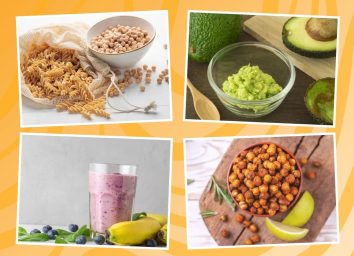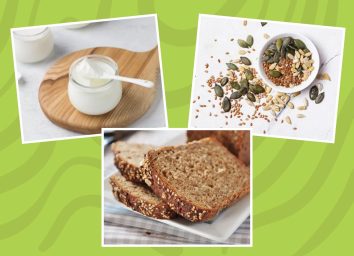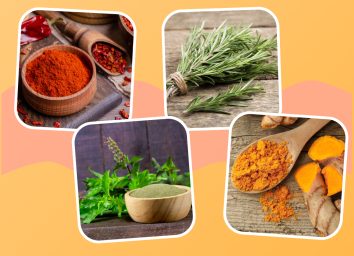What Happens To Your Body When You Eat Steak
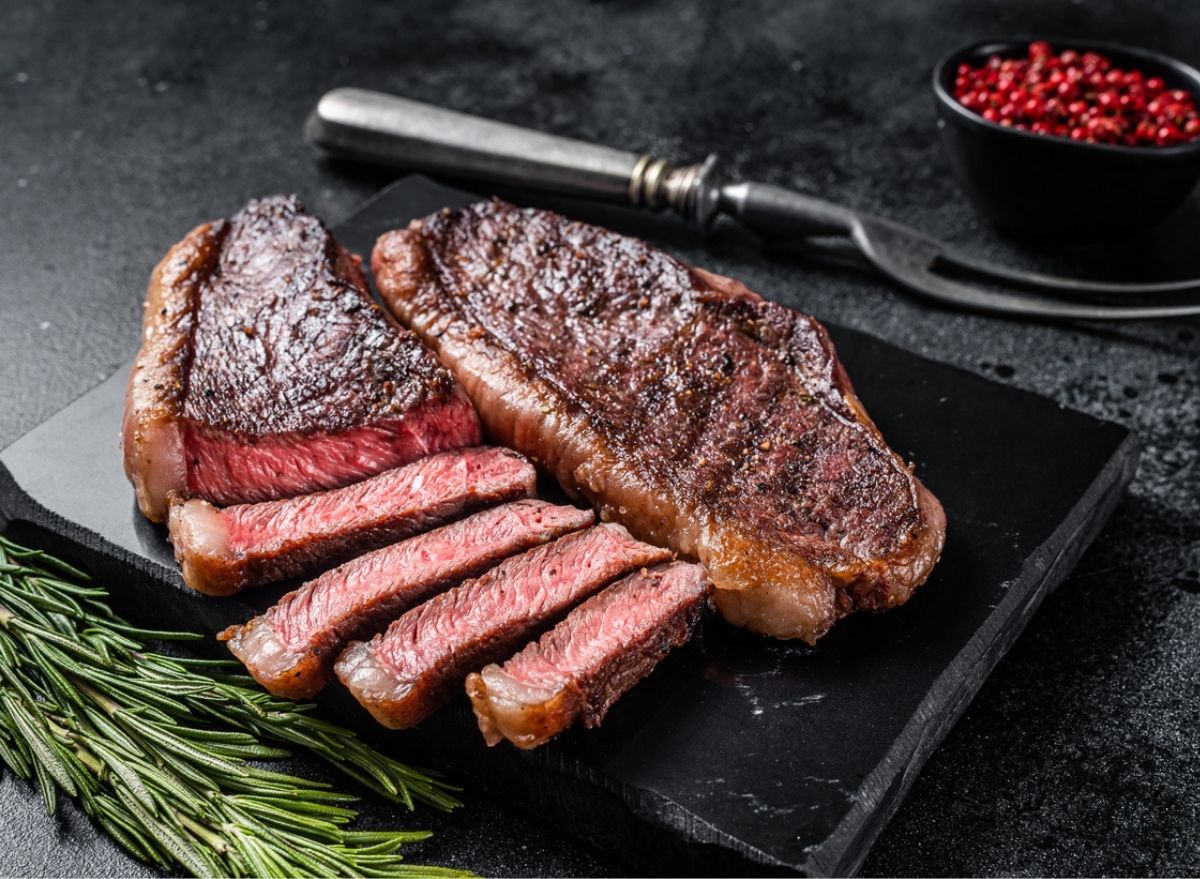
Whether you're serving up a stir fry with flank steak or cutting into a tender filet mignon, steak will satisfy your taste buds every time. But even though steak is a beloved choice of meat by many, the discussion of whether or not steak is healthy has been split down the middle for years. Some speak to the benefits of the nutrients and vitamins it provides, while others say the saturated fat content is too high.
The nutrition information of four popular cuts of steak.
In general, all cuts of steak have similar levels of nutrients and offer related health benefits or side effects, but there is some variation due to the fact that the cuts come from different parts of the cow. For example, some cuts have more calories from fat or more protein. Here is the nutrition information for four popular cuts of steak:
Ribeye (4 ounces)
- Calories: 191
- Protein: 22.6 grams
- Total fat: 10.6 grams
- Saturated fat: 4.1 grams
- Carbohydrates: 1.3 grams
Top sirloin (3 ounces)
- Calories: 150
- Protein: 26.2 grams
- Total fat: 4.3 grams
- Saturated fat: 1.6 grams
- Carbohydrates: 0 grams
Tenderloin (4 ounces)
- Calories: 271
- Protein: 22.4 grams
- Total fat: 20.2 grams
- Saturated fat: 8.1 grams
- Carbohydrates: 0 grams
Flank steak (4 ounces)
- Calories: 186
- Protein: 24 grams
- Total fat: 9.4 grams
- Saturated fat: 3.9 grams
- Carbohydrates: 0 grams
Even after looking at the nutrition information, it can still be difficult to determine if steak is healthy, or if you should skip it next time. With most things, moderation is key, and talking with your doctor can be helpful to ultimately determine whether or not you want to continue making steak a part of your regular diet.
Read on to learn about some benefits of eating steak, as well as possible side effects that come with it. Then, for more healthy eating tips, check out What Happens to Your Body When You Eat Bacon.
What happens to your body when you eat steak?
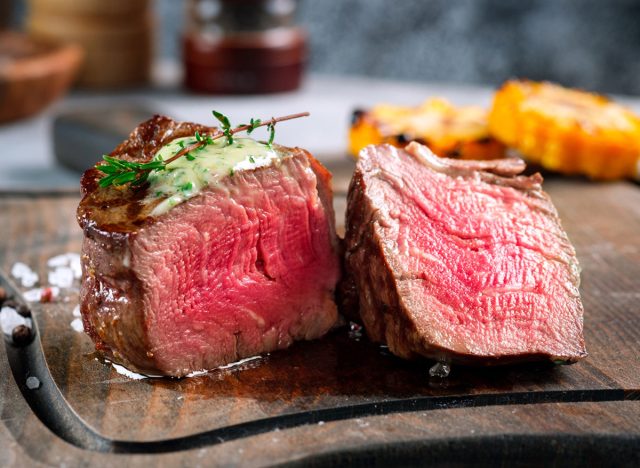
Here are 5 benefits of eating steak.
You'll get a large dose of protein.
One of the best health benefits you can gain from any type of meat is the hefty protein boost it offers—and steak is no exception. The protein content varies depending on the cut, but as an example, you'll get about 24 grams in a serving of flank steak, 22 grams in ribeye, 22 grams in a tenderloin serving, and 26 grams in top sirloin.
"Steak provides a good source of protein, which is important for muscle growth and tissue repair," says Lisa Young, PhD, RDN. "Its high protein content helps with satiety, regulating appetite, and helping to prevent overeating."
Also, steak is considered a complete protein, meaning it contains all nine essential amino acids that the body can't make on its own. Many plant-based proteins are incomplete proteins (they don't contain the nine amino acids), so meat like steak can offer you what some vegetarian-friendly proteins can't.
You'll get closer to meeting your iron requirements.
Along with protein, steak can help you meet your daily goals for micronutrients like iron. Unless you're anemic, pregnant, or have really heavy periods, iron may not be a nutrient you think about often, but if you don't meet your iron requirements through your diet, you may experience a deficiency that can bring on exhaustion, muscle weakness, gastrointestinal discomfort, and lack of physical and mental energy.
Your body uses iron to make two types of protein: hemoglobin and myoglobin. These proteins are needed to transfer the oxygen from your lungs to the rest of your body, according to the National Institutes of Health (NIH). Women usually need more iron than men because people who menstruate are more likely to be iron deficient due to blood loss. So, the daily value for women ages 19-50 is 18 milligrams and 8 milligrams for men ages 19-50.
You can get iron through a variety of animal and plant-based products, such as beef, seafood, poultry, white beans, fortified cereals, lentils, spinach, and nuts. The NIH emphasizes that even though you can get iron through plant-based sources, the body doesn't absorb the type of iron found in plants (nonheme) as well as the iron found in animal products (heme). "Furthermore, heme iron also aids the absorption of non-heme iron in plant-based foods when consumed together," says Young.
If you're able to consume meat, the occasional serving of steak can help you reach your iron goals by providing around 1-5 milligrams per serving depending on the cut—with skirt steak usually providing the most.
You'll be closer to reaching your daily recommended intake of zinc.
You've most likely heard of zinc in some capacity related to immunity, and it's for good reason. This micronutrient is essential for the health of your immune system and metabolism, and thankfully it is abundant in many foods, including your favorite cut of juicy steak. You'll notice zinc is present in many cold medicines because it can help your immune system fight off various illnesses, especially during pesky cold and flu season. But if it's just the typical daily amount you need, steak can help you get there.
The daily recommended value of zinc is 8 milligrams for women and 11 for men, and most people can meet these suggested amounts with the food they eat daily. Foods like beef, seafood, fortified breakfast cereals, and certain seeds can get you pretty close to the DV in one serving, and a serving of oysters can give you almost 300% of what you need!
All cuts of beef will give you a boost of zinc, but if you're intentionally shooting for the most, you'll find over 9 milligrams in a serving of boneless ribeye. Most other cuts will give you 2 or 3 milligrams at the least, which will still make a dent in your goals.
You'll be closer to your daily recommended value of selenium.
Selenium is one of the less talked about vitamins that your body needs, but that isn't a reflection of how valuable it is. According to the National Institutes of Health, selenium is necessary for protecting your body from infection and oxidative stress, as well as helping with reproductive health, the production of DNA, and the health of your thyroid gland.
What steak lovers will be happy to learn is that one serving of this delicious meat can get you close to half of your recommended daily value. The DV for selenium is 55 micrograms, and you'll get 28 micrograms from ribeye, 24 micrograms from tenderloin, 26 micrograms from flank steak, and an impressive 33 micrograms from a top sirloin.
You'll consume nearly all of the B vitamins.
According to Young, another benefit of cooking up a delectable steak is that along with nutrients like protein, iron, selenium, and zinc, this red meat also contains most of the B vitamins your body needs, "which help to support healthy brain function and energy metabolism," as well as providing a multitude of other benefits to your health.
Steak carries almost the entire B vitamin family with thiamin (B1), riboflavin (B2), niacin (B3), B6, folate (B9), and B12. Thiamin is required for energy metabolism and growth development, riboflavin helps with cell growth and energy production, niacin helps turn food into energy inside the body, vitamin B6 is essential for brain health and immunity, folate is required for DNA formation, and vitamin B12 helps with nerve and cell health while also helping to prevent weakness and energy depletion. "The vitamin B12 content in steak is also crucial for DNA synthesis and the production of red blood cells," adds Young.
As you can see, steak is nothing short of nutrient-dense and can provide your body with far more vitamins and minerals than you could imagine. However, this doesn't exempt steak from having potentially negative side effects as well.
Here are 3 potential negative side effects of eating too much steak.
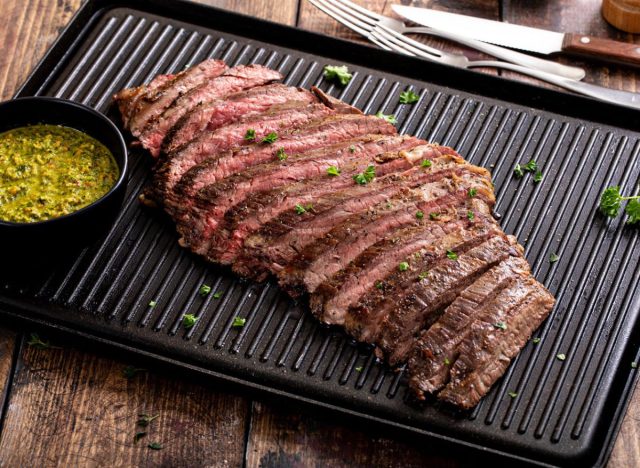
Steak is a nutrient-dense food, but there are some potential downsides to eating too much of it regularly.
Steak contains saturated fat, a nutrient that should be limited in the diet.
The question of whether steak (and red meat in general) is good or bad for you is a highly debated topic, and a good chunk of this controversy comes from the amount of saturated fat red meat carries. "There are potential drawbacks to steak consumption, with certain cuts containing high levels of saturated fat and cholesterol," says Young.
For instance, you'll get about 8 grams of saturated fat in a serving of steak tenderloin, and the American Heart Association recommends limiting your daily consumption to around 13 grams.
Saturated fat is a type of fat that is most commonly found in animal products, and in moderation, it doesn't raise too much concern, but excess consumption of saturated fat has been linked to an increased risk of cholesterol and coronary heart disease.
However, the real controversy comes into play with some recent research reports claiming that the connection between saturated fat and heart disease risk may actually be less significant than what was originally thought. A report published in Current Opinion in Endocrinology, Diabetes and Obesity concluded that there is no real effect that saturated fats have on cardiovascular disease and cardiovascular mortality.
Because the findings are mixed on the health risks of saturated fat, it's best to talk with your doctor about your individual needs, especially if you're someone who eats steak or other red meat regularly.
There is a possible link between red meat and heart disease, but the research is mixed.
Similarly to the conversations around saturated fat, the findings related to red meat and heart disease are also mixed. Recent research within the past couple of years has found varied results on whether consuming red meat can increase your risk of cardiovascular disease.
One 2022 study published in the American Heart Association's journal Arteriosclerosis, Thrombosis, and Vascular Biology found that higher consumption of red meat was connected to a greater increase in the risk of cardiovascular disease, with the leading theory that it has to do with the way your digestive tract is altered after eating it. Researchers in a 2020 study published in the British Medical Journal concluded that red meat consumption was connected to a "modest" increase in coronary heart disease and that switching out red meat with "high-quality" plant foods like legumes, soy, or nuts may help lower your risk.
However, a 2021 study published in the American Journal of Clinical Nutrition concluded that there were no significant connections between unprocessed red meat and heart disease, but there was a connection between processed red meat and heart disease—think sausage, pepperoni, bacon, etc. An earlier study from the American Journal of Clinical Nutrition also found that red meat was not linked to a change in blood lipids or blood pressure levels—both of which are common factors that lead to an increased risk of heart disease.
Studies show a possible connection between red meat and cancer.
Unfortunately, there may be a connection between the consumption of red meat and cancer risk. A 2021 meta-analysis published in the European Journal of Epidemiology, which looked at 148 research articles, found that both processed and unprocessed red meat intake was related to an increased risk of certain cancers. For unprocessed red meats (like steak), the risk increased for breast cancer, colorectal cancer, colon cancer, lung cancer, endometrial cancer, and rectal cancer.
It's also important to note that the World Health Organization (WHO) has labeled red meat as a group 2A carcinogen. According to the WHO, when something is placed into this group, it means that there is "limited evidence from epidemiological studies." They further explain that there has been a "positive association" observed but that other factors weren't ruled out, meaning they can't guarantee the higher cancer risk was caused by the consumption of red meat.
- Source: https://fdc.nal.usda.gov/fdc-app.html#/food-details/174700/nutrients
- Source: https://fdc.nal.usda.gov/fdc-app.html#/food-details/168636/nutrients
- Source: https://fdc.nal.usda.gov/fdc-app.html#/food-details/169545/nutrients
- Source: https://fdc.nal.usda.gov/fdc-app.html#/food-details/169433/nutrients
- Source: https://fdc.nal.usda.gov/fdc-app.html#/food-details/169433/nutrients
- Source: https://fdc.nal.usda.gov/fdc-app.html#/food-details/168636/nutrients
- Source: https://www.ncbi.nlm.nih.gov/pmc/articles/PMC6566799/
- Source: https://www.ncbi.nlm.nih.gov/pmc/articles/PMC8970868/
- Source: https://www.ncbi.nlm.nih.gov/pmc/articles/PMC4258944/
- Source: https://pubmed.ncbi.nlm.nih.gov/32768415/
- Source: https://onlinelibrary.wiley.com/doi/10.1002/oby.23578
- Source: https://health.clevelandclinic.org/do-i-need-to-worry-about-eating-complete-proteins/
- Source: https://ods.od.nih.gov/factsheets/Iron-Consumer/#:~:text=Iron%20is%20a%20mineral%20that,iron%20to%20make%20some%20hormones.
- Source: https://ods.od.nih.gov/factsheets/Iron-Consumer/#:~:text=Iron%20is%20a%20mineral%20that,iron%20to%20make%20some%20hormones.
- Source: https://fdc.nal.usda.gov/fdc-app.html#/food-details/173379/nutrients
- Source: https://www.mayoclinic.org/drugs-supplements-zinc/art-20366112
- Source: https://ods.od.nih.gov/factsheets/Zinc-HealthProfessional/#:~:text=FDA%20developed%20DVs%20to%20help,years%20and%20older%20%5B12%5D.
- Source: https://fdc.nal.usda.gov/fdc-app.html#/food-details/174700/nutrients
- Source: https://ods.od.nih.gov/factsheets/Selenium-Consumer/
- Source: https://fdc.nal.usda.gov/fdc-app.html#/food-details/174700/nutrients
- Source: https://fdc.nal.usda.gov/fdc-app.html#/food-details/169545/nutrients
- Source: https://fdc.nal.usda.gov/fdc-app.html#/food-details/169433/nutrients
- Source: https://fdc.nal.usda.gov/fdc-app.html#/food-details/168636/nutrients
- Source: https://ods.od.nih.gov/factsheets/Thiamin-HealthProfessional/
- Source: https://www.mayoclinic.org/drugs-supplements-niacin/art-20364984#:~:text=Overview,from%20the%20food%20they%20eat.
- Source: https://www.mayoclinic.org/drugs-supplements-vitamin-b6/art-20363468#:~:text=Overview,chickpeas%2C%20bananas%20and%20fortified%20cereals.
- Source: https://ods.od.nih.gov/factsheets/Folate-Consumer/#:~:text=Folate%20is%20a%20B%2Dvitamin,foods%20and%20most%20dietary%20supplements.
- Source: https://ods.od.nih.gov/factsheets/VitaminB12-Consumer/#:~:text=on%20Vitamin%20B12.-,What%20is%20vitamin%20B12%20and%20what%20does%20it%20do%3F,makes%20people%20tired%20and%20weak.
- Source: https://www.heart.org/en/healthy-living/healthy-eating/eat-smart/fats/saturated-fats
- Source: https://www.bmj.com/content/355/bmj.i5796
- Source: https://www.ncbi.nlm.nih.gov/pmc/articles/PMC9794145/
- Source: https://newsroom.heart.org/news/increased-heart-disease-risk-from-red-meat-may-stem-from-gut-microbe-response-to-digestion
- Source: https://www.sciencedirect.com/science/article/pii/S0002916522004282?via%3Dihub
- Source: https://link.springer.com/article/10.1007/s10654-021-00741-9
- Source: https://www.who.int/news-room/questions-and-answers/item/cancer-carcinogenicity-of-the-consumption-of-red-meat-and-processed-meat


